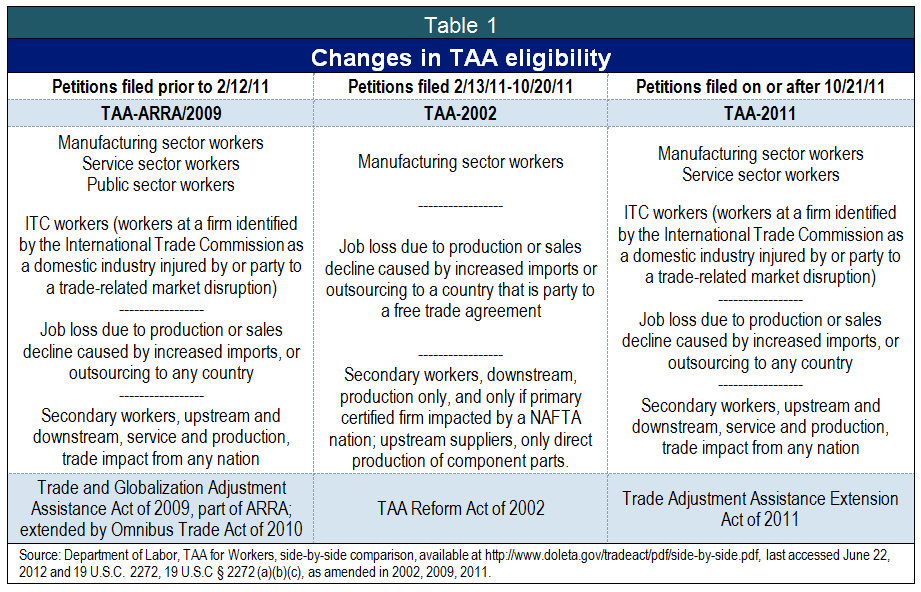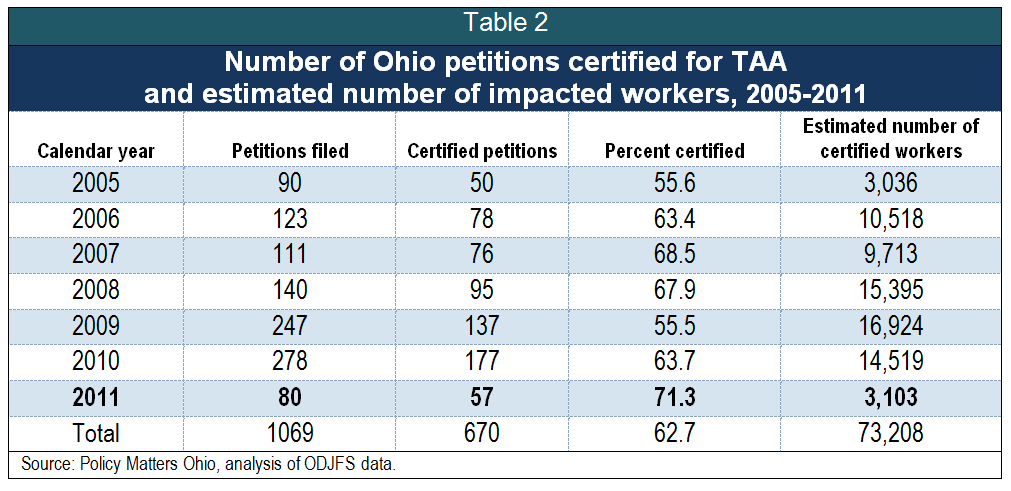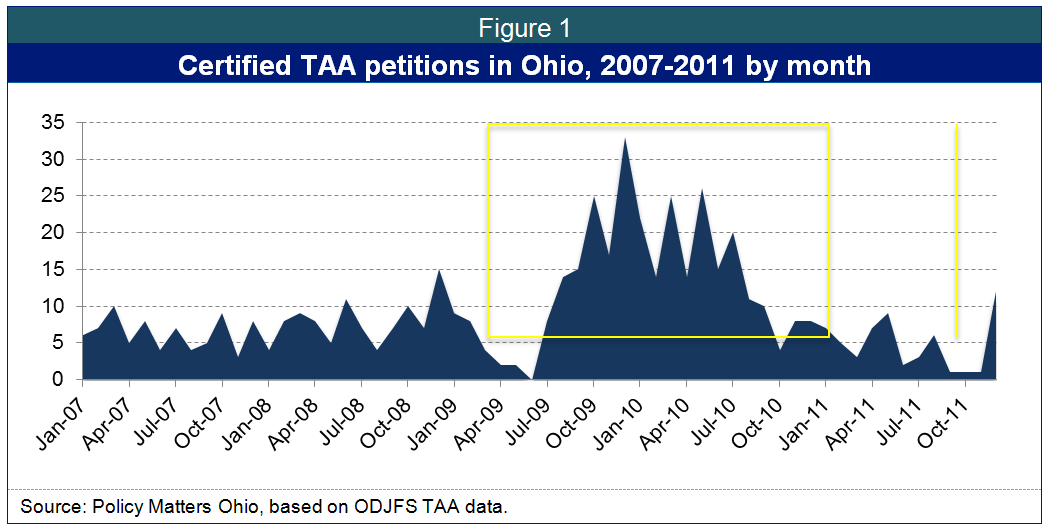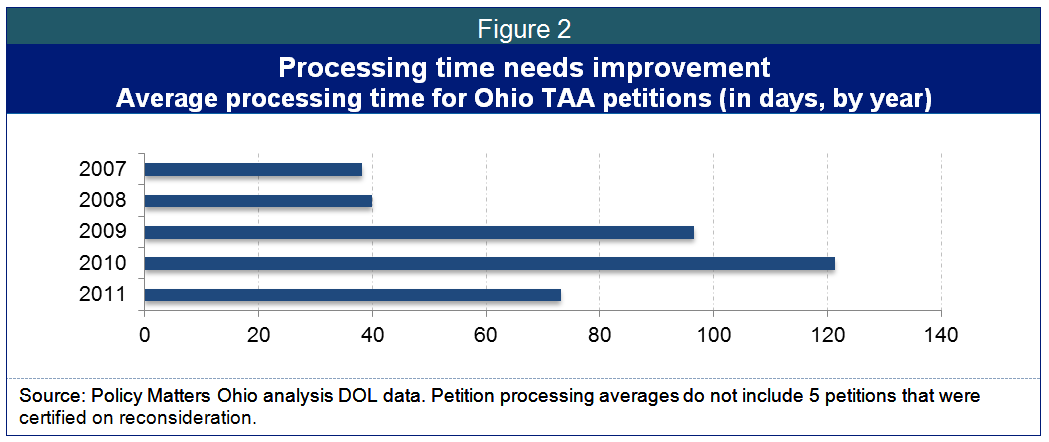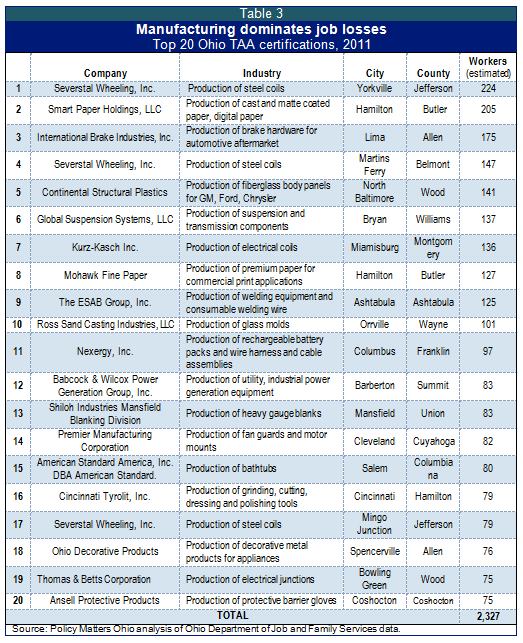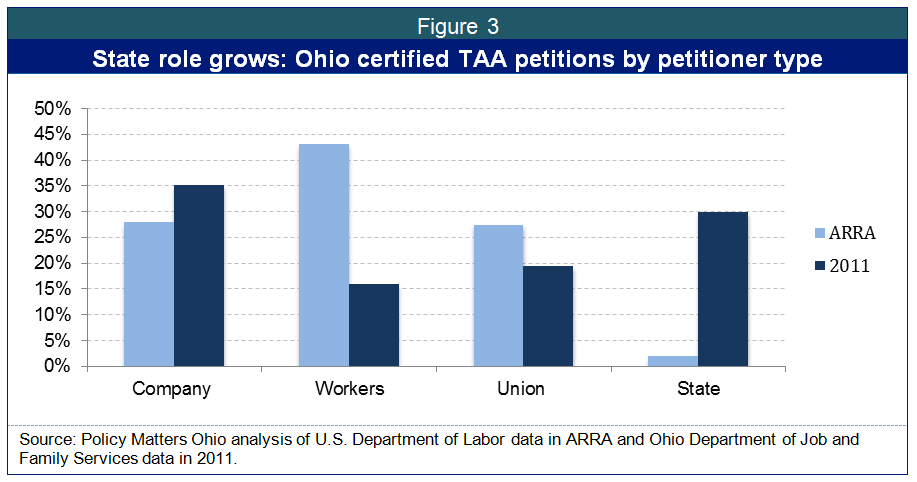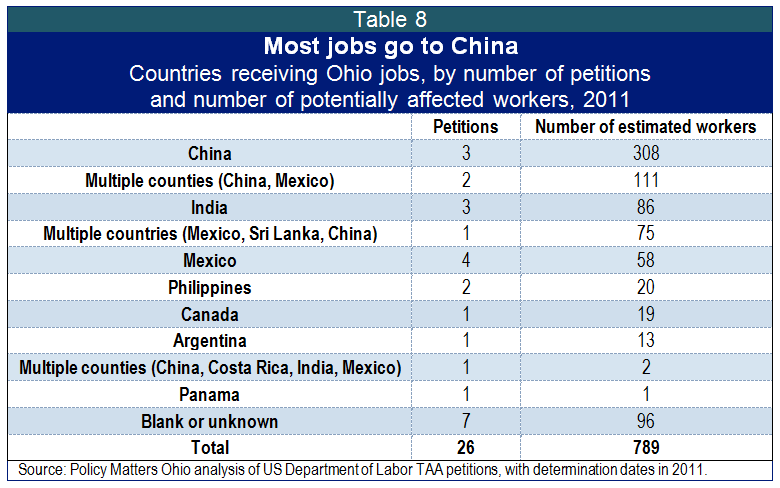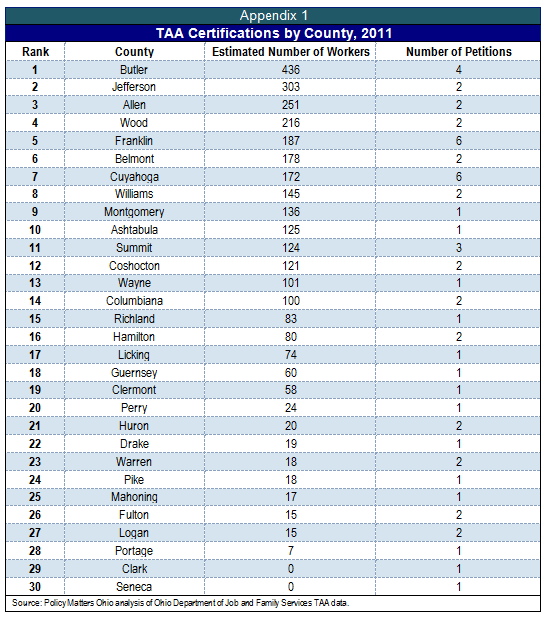
Trade Adjustment Assistance in Ohio
October 15, 2012
Trade Adjustment Assistance in Ohio
October 15, 2012
Trade adjustment assistance is a lifeline that gives dislocated American workers the best chance of getting retraining and finding a new, quality career.
Download report
Download summary
Press release
Globalization promises that all boats rise on the tide of free trade, but policies promoting it have left the United States with a hefty trade deficit. A growing trade deficit usually results in increased job loss in the U.S, as imports replace products once made in the states, and direct outsourcing moves jobs overseas.[1] Between 2001 and 2011, Ohio is estimated to have lost 95,900 jobs to increased imports from China alone.[2]
Overview 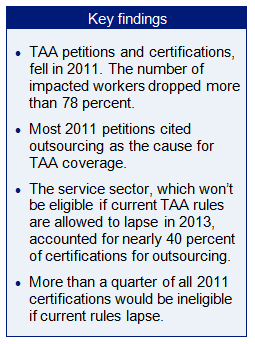
The federal Trade Adjustment Assistance (TAA) program was established to mitigate the economic and personal harm caused by trade-related job loss. During the 2007 recession, Ohio saw record numbers of workers become eligible for the program. In 2011, the second year of the recovery, the number of petitions certified under the program and the number of impacted workers has sharply declined.
Eligibility requirements and benefits have varied since the program’s enactment in 1974. TAA has generally provided subsidized training, a refundable tax credit for health coverage, case management and some income support to eligible workers who exhaust unemployment insurance benefits. TAA provides more comprehensive support than unemployment compensation and is available for a longer period of time, going beyond even the 99 weeks of unemployment compensation that was available under federal extended UC benefits until earlier this year.
Certification and eligibility
Qualifying for TAA is a two-step process. A petition must be filed with and certified by the U.S. Department of Labor (DOL). The petition can be submitted by the company, the state (usually through a One-Stop center), a union, or by a group of three or more workers. A copy of the petition must also be submitted to the office of the governor.
The DOL conducts an investigation into the layoff to determine whether trade caused the layoff, either through increased imports or direct relocation of production to foreign locations. Secondary workers can be certified as downstream producers if they performed direct, value-added production processes, or services to an impacted firm. So, for example, a firm providing final assembly services to a trade-impacted firm may qualify. Secondary workers can also be certified if they were suppliers, producing component parts or services used in production by a trade-impacted firm. Component part makers may qualify as import-impacted firms if they can show an increase in imports of the part or an increase in imports of the completed products into which their parts are assembled. For example, a company producing parts for transmissions could be certified if imports of the specific part or completed transmissions increased, driving down their business.
After DOL certification, the individual workers covered by the certification must then apply for TAA services through the state’s One-Stop system. To qualify, workers must meet additional eligibility requirements, including:
- Worked at an impacted firm on or after the DOL-designated impact date and within two years of DOL certification;
- Worked at least 26 of the preceding 52 weeks before the layoff;
- Is entitled to state unemployment insurance (UI) benefits;
- Is not disqualified from extended unemployment benefits, and;
- Is enrolled in or has completed a TAA-approved training program, or has received a training waiver, if seeking the trade readjustment allowance (TRA) benefit.[3]
In Ohio, the state Department of Job and Family Services (ODJFS) receives notice of the certification from the DOL, then requests and receives a list of impacted workers from the affected business. ODJFS then mails the workers a packet explaining the benefits available and how to apply for services. The Ohio TAA program is primarily coordinated from the central ODJFS office in Columbus by staff trained on the TAA program. Local One-Stop Career Centers provide benefit, rights, information and orientation sessions, and communicate with the appropriate county partners and the central office. Ohio has a common registration system for TAA, the Workforce Investment Act, and UI, allowing the state agency to better integrate these programs. Ohio’s rapid response system, an outreach and service delivery program designed to respond to mass layoffs, also includes TAA screening and application assistance. ODJFS also works with trade-certified employers to identify and notify direct and indirect suppliers, and customers who may also be trade-impacted. The state also notifies employers and claimants who report trade related layoffs through the unemployment compensation office about the program.[4]
In 2011, lapsing statutory authority and political gamesmanship surrounding new trade agreements with South Korea, Colombia, and Panama led to the DOL operating three different versions of the TAA program. Eligibility and benefits varied widely depending on when the petition was filed. Petitions filed on or before February 12, 2011 were covered by the American Recovery and Reinvestment Act of 2009 TAA program rules. Those filed between February 13 and October 20, 2011 are covered by 2002 program rules. And those filed on or after October 21, 2011 are covered by the Trade Adjustment Assistance Extension Act of 2011 (TAAEA). As outlined in Table 1, eligibility requirements under the 2002 statute were very narrow compared to the ARRA expansion and the 2011 program rules.
Under the 2002 law, TAA only covered manufacturing workers who lost jobs due to increased imports or to outsourcing to a country party to a free trade agreement with the U.S. Secondary worker certification was also more restrictive. The American Recovery and Reinvestment Act (ARRA) of 2009 greatly expanded TAA to cover public sector and service industry workers who lost jobs because of declines in production or sales and outsourcing of jobs to any country. ARRA also expanded TAA for secondarily-impacted workers. While the TAAEA of 2011 returns TAA eligibility to service sector workers, it excludes public sector workers from eligibility.
The TAAEA of 2011 provides current filers a range of services similar to those available under the ARRA expansion, including:
- Maximum 130 weeks of Trade Readjustment Allowances (TRA), weekly cash payments to workers enrolled in a full-time training course and who have exhausted their unemployment benefits (previous UI payments count against this total);[5]
- An extended training enrollment period, allowing workers to enroll in training within 26 weeks of certification or layoff;
- Training assistance, approved training can be paid for with limitations on the type of program, duration, and cost;
- Job search allowance for transportation costs, cash payments to workers who cannot find employment within 50 miles of residence, 90 percent of job search costs, maximum of $1,250.
- Relocation assistance, cash payment to workers relocating for employment, 90 percent of allowable relocation costs, plus an additional payment of $1,250 at state’s discretion;
- Health coverage tax credit helps workers pay for qualified health insurance premiums for themselves and their families, paid at 72.5 percent of premium costs, available to workers receiving TRA.
- Reemployment Trade Adjustment Assistance, cash payment to workers age 50 and over who cannot obtain new employment with pay comparable to the lost job, does not require additional group certification, available to workers earning less than $50,000, maximum total benefit $10,000. [6]
TAAEA of 2011 expands the program’s eligibility requirements from the 2002 rules that were in effect for much of last year, more accurately reflecting the impact of trade on local economies. Benefit levels under TAAEA are a mix of the 2009 and 2002 law. Workers are limited to 130 weeks of training assistance, with the last 13 weeks only available for program completion, which is similar to the 2002 maximum rate. Workers have up to 26 weeks from certification or layoff to enter training, compared to the 2002 limit of 8 weeks from certification or 6 from layoff. Workers have much more time to regroup from the shock of job loss and make the decision to invest in training.
The DOL is reconsidering petitions that were denied during the 2002 gap coverage period under the 2011 rules and workers who received their initial certification during this period may elect to receive 2011 benefit package. The current rules are in place until December 31, 2013, when a reduction in benefits and more restrictive eligibility requirements will take effect. The program is set to expire the following year, December 31, 2014.[7]
Trends
Fifty-seven Ohio TAA petitions were certified in 2011, a drop of nearly 68 percent from 2010. The estimated number of workers impacted by TAA fell an astonishing 78.6 percent. Petition filings are down from a record 278 in 2010 to only 80 in 2011, a drop of more than 71 percent. As demonstrated by Table 2, 2011 had the lowest number of petitions filed, petitions certified, and the lowest estimated number of impacted workers in six years.
For a state that has lost more than 320,000 manufacturing jobs since 2001, this remarkable decline in the number of firms and workers negatively impacted by trade is good news.[8] Certainly, some of the improvement can be attributed to the gains made in manufacturing. Manufacturing has been one of the primary drivers of Ohio’s recovery. The sector has added more than 49,000 jobs to the Ohio economy since the end of the last recession thanks in part to a reinvigorated American auto industry.[9] More things are being produced in Ohio and that is a good thing.
This major drop in the number of TAA certifications is good news, implying decreased negative trade impact. However, a portion of the reduction is likely because most 2011 filers were subject to the restrictive 2002 eligibility requirements. Certifications and the estimated number of impacted workers sharply increased under the expanded eligibility. In 2009, there were 137 certifications impacting an estimated 16,924 workers.[10] In 2010, the number of petitions certified by the DOL grew to a record 177, but the estimated number of impacted workers declined to 14,519.[11]
ARRA expanded TAA guidelines to include new segments like the service sector. ARRA also made eligible those hurt by outsourcing and downstream producers to any country, not just countries party to a free trade agreement.[12] These guidelines were not in place for much of 2011. While the DOL is reconsidering petitions filed during the 2002 gap, there is no way to determine the number of petitions that were never filed because they fell outside of guidelines at the time.[13]
Figure 1 shows the fluctuation in TAA certifications since 2007. The chart demonstrates that far more petitions were certified under the ARRA eligibility expansion. Petitions jumped in 2009 when eligibility was expanded and remained high until the end of 2010. There was a slight increase in petitions filed in late 2010, prior to the rule change. The ARRA expansion and TAAEA implementation are highlighted.
The average number of workers certified per petition has been declining since the start of the last recession, from 162.0 in 2008 to 54.4 in 2011. This trend suggests that trade is hurting fewer firms but also smaller firms, and smaller numbers of workers at large firms. It’s also possible that many of the large firms at risk from import competition or with the inclination to outsource have already downsized or closed, meaning certifications are decreasing because we’ve hit bottom in terms of at-risk manufacturing.
Smaller worker groups and smaller firms also means that many trade-related layoffs are not triggering rapid response services or notification requirements under the WARN Act. Ohio has worked to integrate the TAA and Rapid Response systems, so that workers reeling from a mass layoff are quickly connected to services, including the best-dislocated worker program, TAA. The WARN Act, one of the primary triggers for Rapid Response services, only applies to employers with 100 or more employees, and to layoffs affecting at least 50 workers. In 2011, the average number of workers per petition dropped to 54 and more than half of all petitions covered fewer than 50 workers. While ODJFS does provide TAA outreach through the unemployment compensation system and works with trade-impacted employers to identify potential secondarily affected sites, this trend suggests that additional pro-active outreach to smaller firms is needed. There may be many other trade-related job closing that are not part of the TAA program because firms and workers were unaware of their options.
Extended unemployment insurance (UI) benefits may have also decreased the urgency for filing TAA petitions. People are far more familiar with UI than with TAA and UI’s enrollment process is much less burdensome, doubly so in years when TAA eligibility guidelines are in flux. With extended benefits in place for much of 2011, it is possible that potentially-eligible workers were applying for UI instead of TAA, even though TAA benefits are far more comprehensive.
Ohio’s downward trend is reflected in the national numbers. Total certifications fell 60.3 percent, from 2,810 certifications in FY2010 (Oct. 1, 2009-Sept. 30, 2010) to 1,115 in 2011.[14] The estimated number of TAA-eligible workers also fell 65.7 percent, from 287,061 workers in FY 2010 to 98,379 in FY2011.[15] Even with the reduced number of certifications, TAA is crucial to Ohio. Ohio is the second largest recipient of TAA reemployment services funding. In fiscal year 2011, the state received $49,963,965.[16] During fiscal year 2011, Ohio workers accounted for 6.3 percent of training participants with 5,423 workers participating in the program. Michigan tops Ohio in both stats, receiving $55,774,244, and is home to 9,969 training participants.[17]
Petition procession time
Far fewer petitions were certified in 2011 than in the prior four years and the time it took the DOL to process petitions also fell, after growing for several years. In Ohio, processing time increased from 39.9 days in 2008 to 96.6 days in 2009, and 121.3 days in 2010. The increased processing time mirrored the increase in petition filing across the nation. Figure 2 shows these changes.
Due to the increase in petitions from Ohio and the nation, 2010 had the longest average processing time. In 2011, as filings slowed, the average processing time fell to 73.1 days. This is a marked improvement but it is still double the average processing times in 2008 and 2007, both higher petition years.
In 2011, the certification with the longest processing time covered DRS Mobile Environmental Systems, a company that manufactured trailers and shelters in Cincinnati.[18] The petition took 237 days to certify and covered an estimated 40 workers. Though affected workers are eligible for regular unemployment compensation while they await TAA certification, increased processing time can make it harder for them to participate in health insurance tax credits and in turn move people away from retraining opportunities.
Top 20 Ohio TAA certifications
In 2011, the twenty petitions that covered the largest number of Ohio workers were all in manufacturing. As Table 3 shows, many of the petitions covered workers in the auto supply chain, steel production, and appliance manufacturing.
The largest single certification covered workers at Severstal Wheeling’s Yorkville plant. This petition is one of four related petitions covering Severstal operations in Martins Ferry, Mingo Junction, and Steubenville, Ohio. Three of these are in the top twenty list, and the 2011 petition alone covers more than 481 Ohio workers. The petitions were originally filed in 2009, denied in 2010, and certified on reconsideration in 2011. In the original filings, some workers at Severstal had not been properly identified as being covered by the parent company certification. It was found that the layoffs were the result of increased imports of steel coils.
Twelve of the top twenty petitions, affecting 1,294 workers, were certified because the work was hurt by increased imports.[19] Four, impacting 474 workers, were certified due to a shift in production (outsourcing).[20] The final four petitions, covering 559 workers, were certified as secondary affected workers producing components for an import-impacted firm.[21] As detailed below, data about the country or countries from which import competition is coming, or the countries to which production has shifted is not consistently captured in the petition data. The U.S. Department of Labor should ensure that such information is captured and reported, which would contribute to more informed policy-making.
TAA certifications by county
While TAA filings fell in 2011, the impacts of trade are still widely felt in the state. Since 2005, an estimated 73,208 Ohio workers have become eligible for TAA benefits.[22] From 1995 through 2011, an estimated 127,051 Ohio workers have been certified for TAA.[23]
The TAA program has assisted workers in 77 of Ohio’s 88 counties. In 2011, firms in 30 counties were certified for assistance. Eight counties have had more than 2,000 eligible workers:[24] Montgomery, Cuyahoga, Stark, Summit, Franklin, Wood, Lorain, and Trumbull. Montgomery County tops the list, both in terms of the number of petitions filed, 62, and the estimated number of affected workers, 9,983.
Table 4 details the counties with the largest number of petitions from 2005-2011.
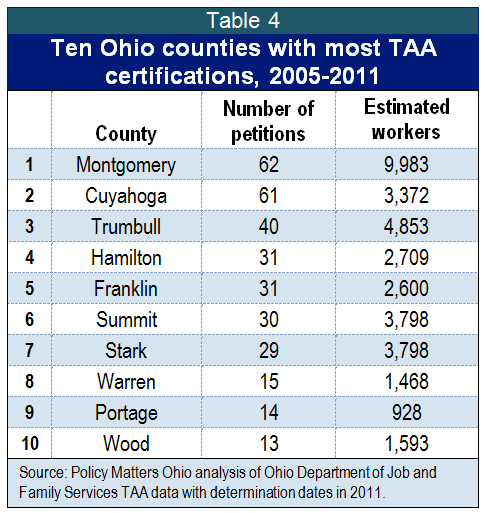 In 2011, Franklin County tied with Cuyahoga County for most TAA certifications (6), impacting an estimated 187 workers. All but one certification in Franklin County were due to a shift in production and four petitions covered service work.[25] Three petitions reported the country receiving the work, WellPoint (Philippines), Affinity Express (Argentina), and Nexergy (China and Mexico). The service-related petitions would not have been certified if the restrictive 2002 rules were in place. The six petitions certified in Cuyahoga County impacted 172 workers. Butler County, with only four petitions, had the highest number of potentially-affected workers, 436. Two of the Butler County petitions came from Worthington Steel and two originated in paper production companies. Nearly half of those workers, 205, came from the Smart Paper Holdings, a subsidiary of Plainfield Paper. The Smart Paper petition cited increased competition from low-priced coated paper from Asia as a cause of the layoffs. Three additional counties, Jefferson, Allen, and Wood had more than 200 workers potentially covered by TAA certifications. Appendix 1, lists all 2011 TAA certifications by county.
In 2011, Franklin County tied with Cuyahoga County for most TAA certifications (6), impacting an estimated 187 workers. All but one certification in Franklin County were due to a shift in production and four petitions covered service work.[25] Three petitions reported the country receiving the work, WellPoint (Philippines), Affinity Express (Argentina), and Nexergy (China and Mexico). The service-related petitions would not have been certified if the restrictive 2002 rules were in place. The six petitions certified in Cuyahoga County impacted 172 workers. Butler County, with only four petitions, had the highest number of potentially-affected workers, 436. Two of the Butler County petitions came from Worthington Steel and two originated in paper production companies. Nearly half of those workers, 205, came from the Smart Paper Holdings, a subsidiary of Plainfield Paper. The Smart Paper petition cited increased competition from low-priced coated paper from Asia as a cause of the layoffs. Three additional counties, Jefferson, Allen, and Wood had more than 200 workers potentially covered by TAA certifications. Appendix 1, lists all 2011 TAA certifications by county.
Certifications by petitioner type, sector, and industry
Unions, groups of three or more workers, the company, or the state can file TAA petitions with the DOL. In 2011, companies took the lead in filing TAA petitions, accounting for 35.1 percent of all petitions filed. The state, primarily through the One-Stop system, filed 29.8 percent of all certified petitions in 2011. Unions were responsible for 19.3 percent and worker groups filed 15.8 percent of petitions.
This is a marked change since the ARRA eligibility expansion, during which worker groups and labor unions filed most of the certified petitions.[26] The state’s share of petitions is growing, amounting to nearly one-third of all petitions in 2011. During ARRA, the state only filed 1.9 percent. Companies also increased their share of petition filing. Figure 3 compares 2011 filing rates to filing rates under the ARRA expansion (May 18, 2009 to May 17, 2010).
Not surprisingly given the change in TAA eligibility that restricted certification to manufacturing sector workers, only ten of the 57 petitions certified in 2011 covered service workers. As shown in Table 5, service workers represented 17.5 percent of all petitions certified, and an estimated 3.7 percent of impacted workers.
Four of the ten service-related petitions covered computer-related services, either in data recovery or programming.[27] Two petitions covered workers in publishing-related fields.[28] The remaining four petitions covered a variety of professional service work, including human resource services, design services, health insurance carriers, and trust, fiduciary and custodial services. Only six of the service petitions listed the country or countries receiving the work and the nations were from around the globe, Panama, China, Costa Rica, India, Mexico, Philippines, and Argentina. Only two of the listed countries are signatories to a free trade agreement with the United States in 2011, Costa Rica and Mexico. [29]
Table 6 lists the industries with the greatest number of potentially-affected workers. Not surprisingly, the top impacted industries were all in the manufacturing sector.
The most heavily impacted industries have also been the subject of U.S. trade disputes under World Trade Organization rules. Of the nine complaints filed by the U.S. with the WTO since 2010, two have concerned cars and car parts, and one covered flat-rolled steel.[30]
Causes for certification
By a slim margin, the most common cause for TAA certification in 2011 was outsourcing – a shift in production to a foreign location. Outsourcing was found in 45.6 percent of all certified Ohio petitions. Outsourcing’s share of TAA certifications is down from 48 percent in 2010. Increased imports resulting in a decrease in sales were responsible for another 42.1 percent of certifications. Secondarily-affected workers accounted for another 12.3 percent of petitions.
More than 60 percent of the jobs lost to outsourcing were from the manufacturing sector. All ten service sector connected petitions were certified due to outsourcing. Though the number of affected jobs was relatively small, this represented nearly 40 percent of all firms that shifted production abroad, a large percentage given the restriction on service worker eligibility in most of 2011.
Although outsourcing was cited in more petitions than import competition, it impacted a smaller number of workers. As shown in Table 7, 51 percent of impacted workers were hurt by increased import competition. Secondarily-impacted workers had the highest worker-to-petition ratio, averaging over 100 workers per each petition filed. Imports had the second highest average, 75 workers per petition. Outsourcing had the smallest ratio, averaging only 30 workers per petition, suggesting that outsourcing is impacting small to mid-sized firms.
For Policy Matters Ohio reports on the TAA program, data on the location of the shift in production was made available by DOL the vast bulk of the time. This was not the case for the 2011 petitions. Many petitions contained only vague references to the competing country, citing “foreign trade” or stating that work has been moved “overseas.” Based on the information listed on the petitions, we know that Ohio jobs were shifted to 9 countries. Table 8 lists those locations, the number of petitions referencing the country and the number of potentially-affected workers.
While the data is less than complete regarding the country to which production was moved, it is clear that several of the countries listed are not parties to a free trade agreement with the United States. Currently, the U.S. maintains free trade agreements with nineteen countries but China, India, Philippines, and Argentina are not signatories to such an agreement.[31] India and China were two of the three most frequently cited nations in the petitions.
Under the 2002 rules that limited certification to manufacturing work, and to countries with which the U.S. has a free trade agreement, at least fifteen petitions, covering 494 workers would not have been certified in 2011. Conversely, since petitions covering such work were not certifiable for roughly two-thirds of 2011, it is all but certain that many petitions were not filed that could have been certified on reconsideration, and the assistance available through TAA did not reach as many workers as it might have if the broader, 2009 criteria did not lapse.
Recommendations
Since 2005, more than 73,000 Ohioans have become eligible for TAA benefits. TAA has been a lifeline in the midst of job loss providing the most comprehensive set of retraining, cash, and health benefits available for the unemployed. In 2011, TAA petitions, certifications, and the estimated number of impacted workers were sharply down, even though the U.S. trade deficit remained enormous. Certainly, some of the decline reflects Ohio’s slow climb out of the 2007 recession, and the related manufacturing upswing. The decline in the number of workers per petition may mean that many of the large employers vulnerable to increased import competition or inclined to outsource have already downsized or closed and are less likely to make big, additional cuts. However, a portion of the decline must be attributed to the herky-jerky rules surrounding TAA reauthorization, and the resulting lapse in eligibility guidelines and workers and firms left unaware of the program.
The TAA program has long had complex eligibility guidelines and a complicated dual application process. The system was made all the more complicated in 2011.Three different sets of eligibility standards and benefits in one year was surely discouraging to workers, companies, and unions seeking to understand their rights and file for certification. Faced with questions about the program’s continued existence, many eligible filers may have opted to accept unemployment compensation instead. The application process for unemployment compensation is much less complex, and with extended benefits the benefit duration was much closer to that offered under TAA, albeit without the health care credit and retraining assistance subsidy.
Without action from policymakers, the current program, including its common sense rules on eligibility will expire on December 31, 2013. Allowing the program to expire will inject additional confusion into an already-complicated system. It would also return the program to the 2002 rules during the final year the program is authorized.
The 2002 rules do not reflect the realities of trade in Ohio. They reject trade-impacted service workers and workers who lose their jobs to non-trade pact nations. More than a quarter (26.3 percent) of all 2011 Ohio certifications would have been denied under the more restrictive scheme. Even with the limited data on importing nations and outsourcing destinations, China was noted in more than 22 percent of the petitions. The U.S. does not maintain a free trade agreement with China. Forty percent of all firms that outsourced production performed service sector work in 2011.
The rules governing the TAA program should match reality and be based on how trade is impacting U.S. workers. Service, information, and professional work is more transferable around the world. It has become clearer than ever that domestic workers harmed by competition from all corners of the globe need assistance, not just those whose jobs disappear because of competition from trade pact nations. The current eligibility rules reflect those changes, and should be maintained. Returning to the 2002 guidelines will prevent many Ohio workers from accessing the program, entering training, and rebuilding their lives.
Trade impacts also appear to be centered on smaller firms and smaller groups of employers. The state outreach system should be proactive in informing small to mid-size firms about TAA. One way to increase outreach is by encouraging one-stops to develop relationships with labor unions and employers in their area. Sector partnerships, which bring together employers, labor, workforce advocates, educators, and trainers to strengthen the regional workforce system, provide a platform to develop partners’ understanding about TAA, and layoff aversion programs.
Open and transparent data collection and distribution is critical to making informed policy decisions and to preserving civic discourse. The TAAEA of 2011 expanded data collection and outcomes reporting on spending and training completion, and training duration. In other ways, the Department of Labor reversed course. In order to secure a reasonable estimate of the number of workers being impacted by TAA certifications, we had to switch data sources in this report after relying on the DOL for data in six previous reports. Also, some pieces of data, such as the importing nation or outsourced location, were not consistently reported in the petitions or in the DOL determination letters. Companies engaged in outsourcing should not be able to hide the impact of their decision by pleading trade secret or confidentiality. Communities deserve accurate information on the impacts of trade. It helps communities better understand their local economy and its place in the world. The DOL should provide full disclosure of the actual number of workers covered by the petitions.
TAA is an important program for workers who have lost their jobs because of trade. It would be more powerful if eligibility rules were stable, clearly articulated, and aligned with the realities of trade impact.
A note on the data
When submitting a TAA petition the petitioner is asked to provide an estimate of the number of workers impacted by the trade-related layoff event. In six previous TAA reports released since 2004, Policy Matters Ohio has relied on this data. In years past, we have found the data DOL provided to be fairly complete. The 2011 data were an exception. Instead of a spreadsheet that included the estimated number of impacted works data, we received a spreadsheet and copies of redacted TAA petitions, both of which listed many vague estimates. Many petitions did not include an estimate of impacted workers and those that did often included an estimate so broad that it was impossible to draw solid conclusions about the number of affected workers. For example, several petitions stated that the number of workers impacted would be in the “hundreds”. We made efforts to supplement the missing data by cross-referencing lay-off events with the Worker Adjustment and Retraining Notification Act mass layoff notices but this led to very few additional data points.
For these reasons, we have used a new data source, ODJFS’s worker list, in computing the number of workers affected by each TAA petition. In this report the terms “estimated number of workers” or “estimated number of potentially affected workers” refers to the number of workers the company reported to ODJFS as being covered by the DOL certification.
Where possible, we have converted our historic data from the DOL data to the ODJFS data. Where DOL data is used, it is noted. We think this is a more accurate picture of the number of workers impacted by this program, but it is likely an underestimate of the number of Ohioans impacted. For example, several of the petitions listed zero (0) affected workers. In these cases the workers were trade impacted but through layoff aversion they were back on the job when certification was finalized. While the workers are back to work, they still experienced the negative consequences of temporary layoff. Additionally, there may be many workers who do not know about the program, the expanded eligibility rules, or how to navigate the petition process.
Further, this report focuses on trade impacts as reflected in the TAA program; it does not capture the total number of Ohioans negatively impacted by trade. The report does not capture all of the indirect job loss caused by employers moving overseas or shutting down due to imports. For example, the Mills Pride (Masco) plant in Waverly, Ohio, was a TAA-certified plant closing in October 2009. The plant eventually closed in early 2011, impacting more than 1,400 workers. This was the largest employer in Pike County at the time of the closing. The number of workers in Pike County affected by this major closing is far greater than the 1,400 certified, as the loss will reverberate through the local economy for years, yet only they are counted.
This report does provide a snapshot of the impact of trade in Ohio, as seen through the lens of the TAA program. It describes in detail where petitions are originating, what sectors and industries are affected, and shows filing trends across several years and across counties, but it can only set a floor for understanding the number of workers, families, and lives impacted by trade.
We would like to thank Olesya Derbedeneva and Victor Matsunaga for their research assistance with this brief, and the Joyce Foundation for generous funding for research on dislocated workers.[1] Robert E. Scott, The China Toll: Growing U.S. trade deficit with China cost more than 2.7 million jobs between 2001 and 2011, with job losses in every state, Economic Policy Institute, August 23, 2012, available at http://www.epi.org/publication/bp345-china-growing-trade-deficit-cost/, last accessed September 24, 2012.
[2] Id.
[3] Benjamin Collins, Trade Adjustment Assistance for Workers, Congressional Research Service, July 2012, pg. 3.
[4] Benjamin Johnson, Deputy Director, ODJFS Office of Communications, email to author, October 4, 2012.
[5] The training requirement can be waived under limited conditions: the worker is unable to participate due to a health condition, no training program is available, or the enrollment date is not immediate. The last 13 weeks of training are only available to complete a program and if certain benchmarks are met. See Department of Labor, TAA program side-by-side comparison, available at http://www.doleta.gov/tradeact/pdf/side-by-side.pdf, last accessed July 25, 2012.
[6] Department of Labor, 2011 Annual Report, available at http://www.doleta.gov/tradeact/docs/AnnualReport11.pdf, last accessed June 22, 2012.
[7] Benjamin Collins, Congressional Research Service, Trade Adjustment Assistance for Workers, July 11, 2012, available at http://www.fas.org/sgp/crs/misc/R42012.pdf, last accessed July 26, 2012.
[8] Hannah Halbert, JobWatch, Policy Matters Ohio, September 21, 2012 available at http://www.policymattersohio.org/jobwatch-september2012.
[9] Policy Matters Ohio calculation based on CES data available at http://ohiolmi.com/asp/CES/CES.asp. Recovery period is June 2009-August 2012, August 2012 data at time of calculation, was preliminary.
[10] Policy Matters Ohio analysis of ODJFS TAA data.
[11] Id.
[12] In our 2010 TAA report, we found that more than 13 percent of the petitions were related to service work. These workers would not have been eligible under the 2002 statute.
[13] DOL’s annual report on TAA to the Committee on Finance of the Senate and Committee on Ways and Means of the House of Representatives, found that as of January 2012, 80 additional petitions were certified after reconsideration. Report available at http://www.doleta.gov/tradeact/docs/AnnualReport11.pdf, pg. 8
[14] Department of Labor, TAA Statistics, FY 2010 available at http://www.doleta.gov/tradeact/TAPR_2010.cfm?state=US, FY 2011 available at http://www.doleta.gov/tradeact/TAPR_2011.cfm?state=US.
[15] Id.
[16] Collins, pg. 16.
[17] Collins, pg. 16. North Carolina also tops Ohio in total number of training participants. North Carolina had 7,443 participants in 2011. Id.
[18] This excluded five petitions certified on reconsideration in 2011. They were originally filed in 2009.
[19] Including the following petitions: Thomas & Betts Corporation, the three Severstal Wheeling, Inc. sites, Cincinnati Tyrolit, Inc., American Standard America, Inc., Kurz-Kasch Inc., Premier Manufacturing Corporation, The ESAB Group, Inc., Ross Sand Casting Industries, LLC., Shiloh Industries Mansfield Blanking Division, Babcock & Wilcox Power Generation Group. Only five petitions listed the country of origin for the increased imports: Cincinnati Tyrolit (China), Kurz-Kasch (Mexico), The ESAB Group (China), Shiloh Industries (Mexico), and Babcock & Wilcox (China and Mexico).
[20] Including the following petitions: Ansell Protective Products, Nexergy Inc., International Brake, and Mohawk Fine Paper. Only one, Mohawk Fine Paper, reported the country that received the work (China).
[21] Including the following petitions: Ohio Decorative Products, Smart Paper Holdings, Global Suspension Systems, and Continental Structural Plastics. Most firms reported increased competition with Mexico (Ohio Decorative Products, Global Suspension Systems, and Continental Structural Plastics). Global Suspension Systems, a supplier to a TAA certified Chrysler firm, also reported increased competition from Australia.
[22] Policy Matters Ohio analysis of Ohio Job and Family Services TAA data.
[23] This figure uses ODJFS data for 2005-2011. For years 1995-2004, we relied on DOL data. We found that for years prior to 2009 the numbers reported by DOL and ODJFS were very similar. Using the combined data set is the only way for us to have an estimated historic total. ODJFS data prior to fiscal year 2004 was not readily available and was not provided to us.
[24] Includes, Montgomery, Trumbull, Summit, Stark, Cuyahoga, Richland, Hamilton, and Franklin.
[25] Franklin County petitions include: iLevel by Weyerhaeuser, JP Morgan Chase, WellPoint, Affinity Express, Sophos, and Nexergy. Only iLevel was certified for a reason other than outsourcing (increased imports). Nexergy and iLevel were reported as manufacturing work, all other Franklin petitions were service related. Only two petitions reported the country receiving the work, WellPoint (Philippines) and Affinity Express (Argentina).
[26] The term ARRA expansion in this instance covers May 18, 2009-May 17, 2010, and reflects data from our 2010 TAA report available at http://www.policymattersohio.org/wp-content/uploads/2010/07/TAA2010.pdf .
[27] Including CSC Managed Services, Siemens IT Solutions, JP Morgan Chase, and Sophos.
[28] Including Cengage, and Affinity Express.
[29] See, United States Trade Representative, Free Trade Agreements, available at http://www.ustr.gov/trade-agreements/free-trade-agreements. A free trade agreement with Panama was signed on October 21, 2011 but has not yet been implemented.
[30] See, World Trade Organization, Chronological list of disputed cases, available at http://www.wto.org/english/tratop_e/dispu_e/dispu_status_e.htm.
[31] United States Trade Representative, Free Trade Agreements, available at http://www.ustr.gov/trade-agreements/free-trade-agreements. Countries party to a free trade agreement with the United States include: Australia, Bahrain, Canada, Chile, Columbia, Costa Rica, Dominican Republic, El Salvador, Guatemala, Honduras, Israel, Jordan, South Korea, Mexico, Morocco, Nicaragua, Oman, Peru, and Singapore. An agreement with Panama has been signed but is not yet impemented. The U.S. is in negotiations of a regional, Asia-Pacific trade agreement, the Trans-Pacific Partnership Agreement (TPP). Id.
Tags
2012Hannah HalbertTradeWork & WagesPhoto Gallery
1 of 22
